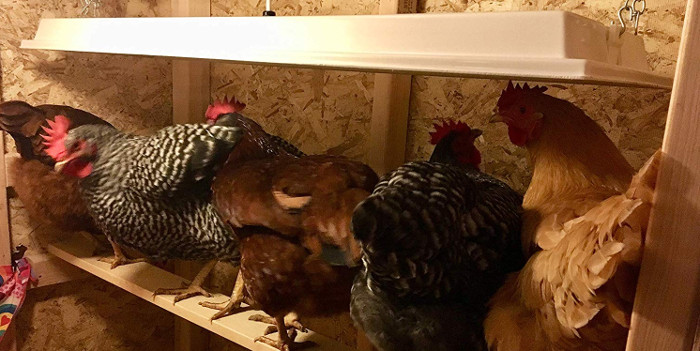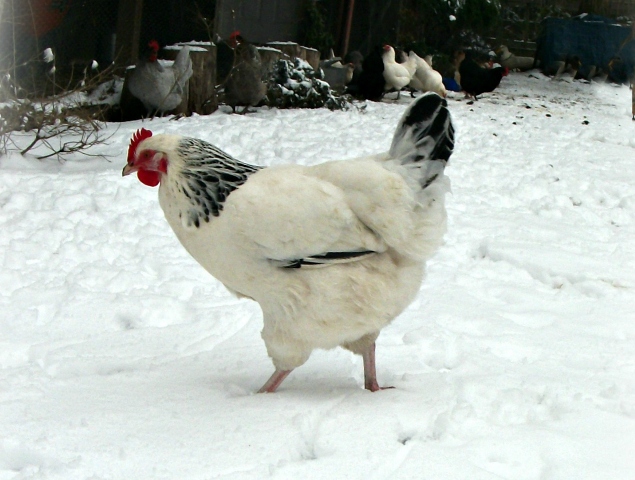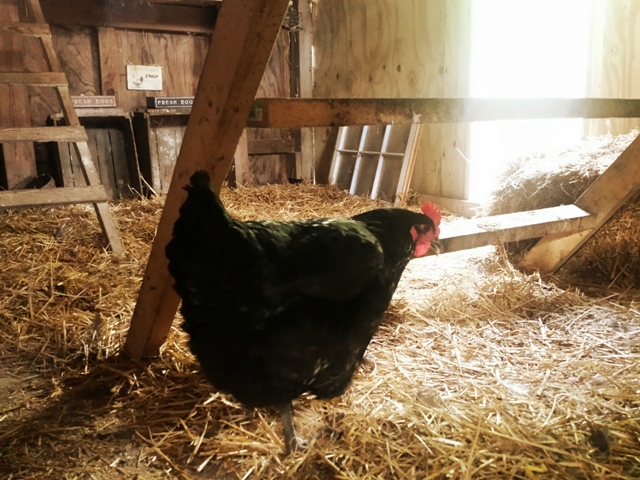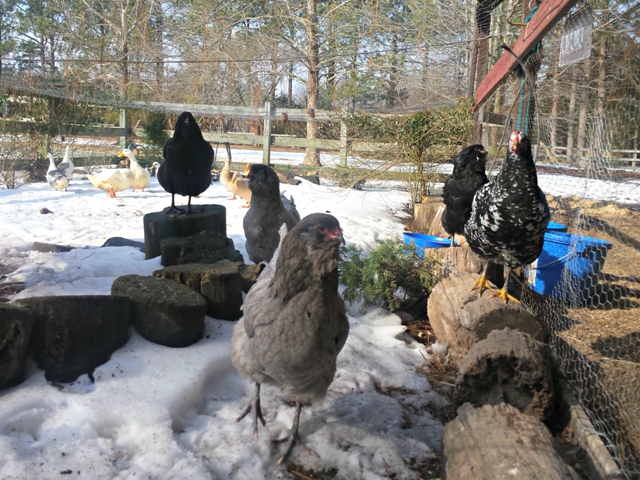By Lisa Steele
You might be surprised to learn chickens don’t need heat in winter. Chickens, like most animals, do far better in the cold of winter than in the heat of summer. As long as your backyard flock is full grown, fully-feathered, and healthy, they should do just fine in a dry, draft-free coop without any heat. In this article I will share my tips of how to keep chickens in winter warm and safe.
Why I Don’t Like Chicken Coop Heaters or Lamps
I have long been an opponent of using a heater or heat lamp in a coop. The combination of electricity—a heat source, chickens, and flammable bedding is a potentially fatal one, and each year there are reports of devastating chicken coop fires despite all the warnings. Even if your heater or heat lamp doesn’t catch fire, heating your coop has some other drawbacks to consider.

Chickens who sleep in a heated coop aren’t allowed the chance to slowly get used to the cold, and if you lose power or the heat lamp burns out, your chickens will have difficulty handling the sudden drop in temperature and could freeze to death. However, as long as they gradually are exposed to colder temperatures, their bodies will adapt. Heat also creates moistures—and frostbite is more often caused by moisture than the cold itself.
So before you rig up a potentially dangerous chicken coop heater or heat lamp, check out some of these easy, effective ways to help your chickens get through winter more comfortably. Even though they will be perfectly fine in temperatures well below freezing, chickens do seem to appreciate a bit of pampering when the winter winds blow!
How to Keep Chickens Warm in the Winter
1. Good Ventilation.
Regardless of whether you heat your coop or not, you want to be sure there is adequate ventilation in the coop. Harmful ammonia fumes, which can cause respiratory problems, build up quickly in an airtight coop. Condensation on the coop windows is an indicator that you don’t have enough ventilation. You can easily solve this problem by cutting some vents up high and covering them with 1/2-inch welded wire to keep predators out. To be sure your coop isn’t drafty, however, you want all the ventilation to be above your chickens’ heads when they’re roosting.
2. Protect Chicken Feet and Combs from Frostbite
The best roosting bars are wide enough so that a chicken’s feet are completely covered from below by the wooden bar and above by their bodies. Exposed feet and combs are most susceptible to frostbite, so by using a 2×4 board for your roosts, with the wide side facing up, you’re helping to protect your chickens’ feet. Apply a bit of softened coconut oil to your larger-combed hens and roosters to help prevent frostbite.
3. Good Chicken Breeds for Winter
Consider cold-hardy breeds if you live in a northern climate. These chicken breeds include the Ameraucana, Australorp, Buckeye, Buff Orpington, Cochin, Delaware, Easter Egger, Faverolle, Jersey Giant, Marans, Plymouth Rock, Rhode Island Red, Sussex, Welsummer. and Wyandotte—all fairly large bodied, small-combed breeds.
4. Winterized Chicken Coops
Insulating your chicken coop traps the body heat that chickens create while they sleep. If your coop isn’t insulated, simply stack bales of straw along the inside walls. Straw, being hollow, has wonderful insulating properties as it traps warm air inside the shafts. Furthermore, straw bales take up “dead air” space and make it easier for the chickens to warm their house using their own body heat.
If there’s no room inside your coop for straw bales, consider stacking them along the outside walls of your coop with a tarp over them as protection from the elements. Come spring, you can use the straw as mulch in your garden or in the run to absorb some of the spring mud. A nice thick layer of chopped straw on the floor of your coop will also help keep your flock warmer through the winter.
The Deep Litter Method is another way to keep the coop warmer. Starting with a fairly thick layer of straw, hay, shavings, pine needles, or even dried leaves, simply turn over the coop litter each morning, then add more as needed to maintain the base, gradually building it up to a foot or more. The organic matter will mix with the chicken poop and begin to decompose, creating heat. As long as you keep turning it to introduce oxygen, it won’t smell and come spring, you will have some beautifully composted material for your garden.
Encourage Outdoor Activities
Chickens don’t seem terribly bothered by the cold, but they don’t like snow or wind. Getting them outside in the sunlight to get fresh air is beneficial, so encouraging your chickens to leave the coop is important. Try putting down some straw to make a path from the coop to a sunny corner of the run so they don’t have to walk on the snow. To block the wind, wrap a corner of your run in plastic, a tarp or even several pieces of plywood. Scattering some treats such as cracked corn or scratch grains can help convince your chickens to venture out of the coop.
Hanging a mirror outside can provide them much amusement, as can making outdoor roosts in the corners of your run, or even setting some logs, stumps or branches out for the chickens to hop onto to get up off the cold ground. Filling a kiddie pool or large tub or tote with some dry sand or dirt and fireplace ash and setting it in a protected area outside allows your chickens to take dirt “baths” through the winter even when the ground is frozen.
What to Feed Chickens in Winter
High-fat, high-energy treats such as cracked corn, warm oatmeal, or peanuts right before bedtime will help keep your flock warm overnight as their bodies work to digest them. These calorie-dense treats will also help to put on a bit of extra weight for winter which will help keep them warm as well. Offering treats to them in the run will also prolong their time outdoors. Homemade suet cakes made with leftover cooking grease, nuts, seeds, or dried herbs can be hung in the run. Pecking at them can help alleviate boredom in your flock as well as provide a warming treat.
Since weeds and grass are scarce during the winter, your chickens will enjoy chard, kale, or other cold-crop leafy greens to munch on. Growing bean sprouts or sprouting wheatgrass indoors for your chickens is another way to provide them a varied diet when there is no grass to eat. You can also hang lettuce or cabbage from a rope or in a hanging basket for your chickens to peck at and to help prevent boredom.
Be sure to check your chickens’ water frequently to be sure it hasn’t frozen. Using a dark tub set in the sun with a ping pong ball or two floating in it can help keep the water unfrozen longer. If you have electricity to your coop, a heated dog water bowl is an inexpensive, easy way to keep the water from freezing. Lastly, be sure to stock up on bedding, feed, and treats in case of blizzard or power outage, or if you are unable to get to the feed store.
Chickens actually need very little in order to be comfortable in cold weather, but these are a few simple things you can do to keep them happier and healthier through the winter months—and to stay warm and busy on those frigid, blustery days.
Lisa Steele is a fifth generation chicken keeper who lives with her husband and flock of two dozen chickens and ducks on a farm in Maine. She is the author of Fresh Eggs Daily: Raising Happy Healthy Chickens … Naturally and the companion duck book titled Duck Eggs Daily. She is also an avid gardener and aspiring herbalist and offers natural poultry-keeping advice on her blog at www.fresheggsdaily.com.










Great article! What about Alaska – would you consider a heat lamp here? It gets well below zero, sometimes for a month or more. Or do you think the straw around the coop would be enough?
Hi Kathrine,
Nope, even in Alaska your chickens should be fine. I have readers who live in Canada, Alaska, even Scandinavia, none of whom use heat lamps. Chickens, and most animals, can get used to anything as long as they are allowed to gradually. A sudden 30 or 40 degree drop in temperature would be tough on them – and I might rig up a heat lamp if something like that is predicted, but as long as its a gradual cooling, their bodies adapt quite well.
We have an thermostat plug which allows the heat lamp to come on if the temperature drops below 36 degrees, I believe. I often put a water jug a yard or so below the lamp to prevent it from hard freezing. The lamp does not stay on unless the temps stay low. Also, my water does not freeze unless the temps stays in the 20s (which is rare, where I live). It is still cool in their coop, but not toasty. Never any moisture.
Thanks for reading, Sheila! Using a heat lamp just depends on personal preference and the potential drop in temperature.
Molly Green Staff
I have Chantecler chickens, who also have very small combs. They were developed up here in Canada to deal with the cold weather we get. My coop last year wasn’t heated, aside from the deep bed method, and none of them had frostbite.